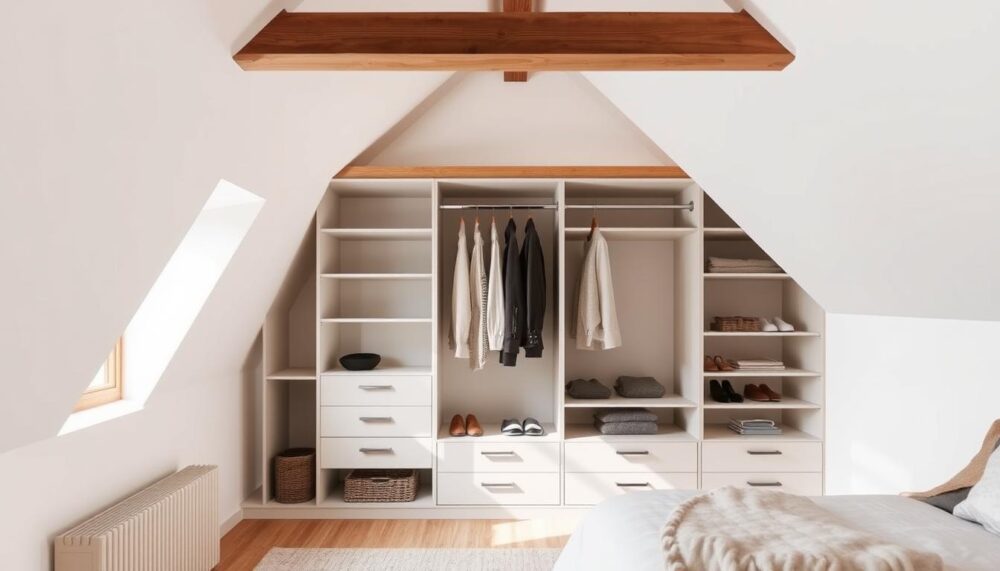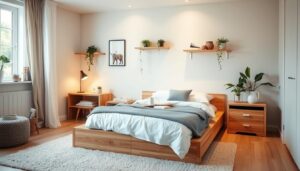Attics and lofts often come with awkward sloping ceilings, making traditional storage solutions impractical. Clever modifications can transform these tricky spaces into functional areas without breaking the bank.
Take Adrian’s METOD kitchen cabinet transformation in Australia. By repurposing affordable units, he created a custom under-eaves wardrobe. This approach saved over £5,000 compared to a cabinet maker’s quote.
Similarly, Peik in Norway integrated a MALM chest into his loft, proving that smart hacks maximise space efficiently. These projects highlight how adaptable designs—like sliding rails and display-worthy drawers—solve spatial challenges beautifully.
Key Takeaways
- Sloping ceilings in lofts require creative storage solutions.
- Repurposing affordable units saves significant costs.
- Customisable drawers and rails enhance functionality.
- Dual-purpose designs balance accessibility and aesthetics.
- Real-world examples demonstrate practical applications.
Why Choose an IKEA Hack for Eaves Storage?
Raked ceilings demand clever solutions to unlock hidden storage potential. Standard wardrobes often fail in these spaces, but modular systems adapt seamlessly to odd angles and low heights.
Maximising Awkward Spaces
Sloped walls limit off-the-shelf options. Custom wardrobe companies, for instance, typically offer rails no longer than 80cm—half the length needed for many lofts. Modular units solve this with adjustable depths and angled fronts.
Weight management is another hurdle. Flimsy retail rails buckle under heavy loads, but reinforced aluminium rails with dowel cores provide sturdy hanging space. Adrian’s METOD hack used this approach to support 160cm of clothing rails effortlessly.
Cost-Effective vs Custom Solutions
Custom-built wardrobes can exceed £4,000, while clever repurposing of flat-pack units slashes costs to £300–£800. Peik’s MALM chest, for example, paired custom birch fronts (£500) with marble tops (£500)—still under £1,100 total.
“A cabinet maker quoted me $6,500 AUD for the same storage. My METOD hack cost just $1,500.”
Standardised sizes also simplify measurements for non-square rooms. Whether integrating plastered gyprock or marble finishes, the flexibility lets you blend functionality with aesthetics.
Planning Your IKEA Hack Eaves Storage
A well-organised loft begins with precise measurements and the right materials. Whether repurposing flat-pack units or building custom frames, preparation ensures a seamless fit for sloped ceilings.
Assessing Your Space and Needs
Start by mapping the room’s angles. Adrian used cardboard templates to trace his ceiling’s slope, while Peik opted for CNC scans to capture intricate edges. Both methods prevent gaps between the wall and furniture.
Consider the room’s purpose: a bedroom might need hanging space, while a study benefits from shallow drawers. Note electrical outlets or pipes that could affect placement.

Selecting the Right Units
Modular systems like METOD excel for deep storage, with Adrian combining 80cm and 60cm cabinets. For compact areas, MALM’s slim profile works well—Peik angled its birch fronts at 15° for better grip.
- METOD: Ideal for heavy-duty drawers (e.g., bedding or tools).
- MALM: Fits tight spaces; easily customised with cut-to-size panels.
Essential Tools and Materials
Gather durable supplies to handle sloped ceilings. Adrian reinforced his frames with 19mm plywood, while Peik used gyprock for a flush finish.
“A router smooths edges on DIY handles—worth the investment for a polished look.”
Tool checklist:
- Jigsaw for cutting panels
- Hex screws and brackets (B&Q or Bunnings)
- Plastering tools for seamless cornices
Step-by-Step IKEA Hack for Under-Eaves Storage
Transforming sloped ceilings into functional spaces requires a methodical approach. Follow these steps to create custom storage that fits seamlessly beneath awkward angles.

Building Drawer Units with METOD Cabinets
Start by reinforcing the base. Adrian used 19mm plywood plinths for stability. Modify cabinet tops with a jigsaw to match the ceiling’s slope—kettlebells act as handy counterweights during cutting.
For deep drawers, combine 80cm and 60cm units. This adapts to varying depths beneath sloping walls. Ensure the edges are sanded smooth for a polished finish.
Creating a Hanging Space with Plywood Frames
Construct rails from 70x35mm pine and aluminium tubing. Adrian’s hanging rail spans 160cm, supported by dowel cores for heavy loads. Use a spirit level to confirm alignment before securing.
Pro tip: Calculate weight capacity in advance—each metre can hold up to 15kg with proper reinforcement.
Installing Doors and Adjusting Hinges
Retrofit METOD hinges onto plywood frames using alignment templates. This avoids gaps and ensures smooth operation. For angled walls, slightly offset the hinges to accommodate the slope.
Test each door before final fixing. Adjust screws incrementally to prevent misalignment.
Finishing Touches: Plastering and Handles
Bridge uneven walls with mesh tape before plastering. Apply multiple thin coats, sanding between layers. Peik repurposed hardwood decking for handles—rounded with a router for a £650 look at minimal cost.
“A router smooths edges on DIY handles—worth the investment for a polished look.”
Conclusion
Creating a functional wardrobe in a loft doesn’t need to break the bank. As shown, clever DIY solutions can save thousands compared to custom builds. Adrian and Peik’s projects prove that mixing modular units with local materials delivers both style and practicality.
For precision, consider using B&Q’s cutting services. Marble remnants add luxury without the cost. Sustainable touches, like repurposed timber handles, elevate the design while keeping it eco-friendly.
Whether it’s child-safe anchored drawers or a visitor-approved Nordic look, these ideas adapt to any home. Ready to start? Explore more bespoke loft solutions for inspiration.
FAQ
How can I make the most of awkward eaves spaces?
Using flat-pack furniture like METOD or MALM units allows you to custom-fit storage into sloped ceilings. Adding drawers or hanging rails maximises every inch.
Are custom-built solutions better than flat-pack hacks?
While bespoke options offer perfect fits, adapting ready-made pieces is far cheaper. With clever adjustments, you can achieve a high-end look for less.
What should I measure before starting the project?
Check the ceiling height, slope angle, and floor space. Note any obstructions like pipes or beams. Precise measurements ensure your units fit snugly.
Which tools are essential for this DIY project?
You’ll need a drill, spirit level, saw, and sandpaper. For finishing, grab filler, paint, and handles. A stud finder helps secure units to walls safely.
How do I install doors on sloped eaves?
Use adjustable hinges to align doors with the ceiling angle. For a seamless look, consider sliding doors or curtains if space is tight.
Can I add lighting inside eaves wardrobes?
Yes! Battery-operated LED strips or puck lights work well. Place them along the top edge to brighten hanging clothes or shelves.
What’s the best way to finish raw edges?
Sand plywood cuts smoothly, then apply trim or iron-on veneer tape. For painted units, use filler to hide gaps before painting.






